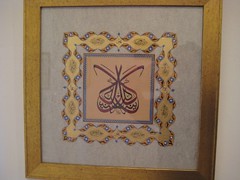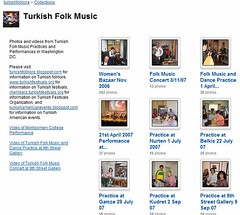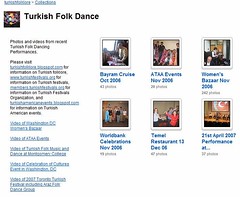 By Gulhis Diptas
By Gulhis DiptasBefore printing press was invented, books were written with reed pens using black ink and Arabic letters on paper that were polished with ahar and muhre.
Ahar: is a mixture made with cornstarch and egg white for polishing the paper.
Muhre: is a device made of glass or stone, used to make paper smooth and shiny.
Important ones were written in “beautiful writing” (Husnu Hat) and embellished with illuminations, marblings, engravings, and miniatures.
Master of books making arts; calligraphers, illuminators, miniaturists, painters, margin specialists and binders in miniature houses, change books into works of arts.
Illumination is the name given to the embellishments, which are made with paints and gold, of manuscript books.
After the invention of printing press, illumination started to disappear. You can see them at museums (with permission). You can also study it in the Academy of Fine Arts.
Since books are not written by hand, illumination is made as book embellishment.
THE ART OF ILLUMINATION
Tezhip-Illumination: The embellishments of manuscripts writing albums called murakka, tablets of ferman and beautiful writing, whether done in paint or gilt, are all defined as illumination.
The word comes from Arabic stem “zaheb”-gold and means gilding or begolding.
Beside the gold; the materials that are used are vegetable dyes, metal oxides, earth-based color dyes, and powder stones.
HOW TO MAKE ILLUMINATION
Like many Turkish arts of traditional origin, illumination depends on the skills of a number of craftsmen working together to create a finished product.
Illumination is generally made after the book is written.
When the calligrapher has completed writing the body of the work, it is the turn of cedvelkes, to rule the margins in gold, or black ink, or red paint calld surh.
Then master punctures of the design worked up by illuminator, who then does the actual drawing of the illumination, alone or with the others.
All this would be carried out in miniature salons at the palace, or in the studio of a great illuminator.
DESIGNS OF ILLUMINATION
 The motifs which have been most often employed in illumination are rumi, consisting of styled wings and beaks; geometric forms like triangle, hexagon, octagon; munhani, serried curves popular with the Seljuks; hatai, which are styled floral motifs; bulut or clods, a swirled effect of Chinese origin; sazyolu or kivrimdal and as an auxiliary motif the tig.
The motifs which have been most often employed in illumination are rumi, consisting of styled wings and beaks; geometric forms like triangle, hexagon, octagon; munhani, serried curves popular with the Seljuks; hatai, which are styled floral motifs; bulut or clods, a swirled effect of Chinese origin; sazyolu or kivrimdal and as an auxiliary motif the tig. It is important in the art of illumination that the various motifs used should make a harmonious whole. The dominant motifs should be set off nicely by the subsidiary ones, while special attention is paid to how much of a page is illuminated and how much left bare.
PERIODS
As Dr. Suheyl Unver claims in his book, as early as the 13th century, in the time of Anatolian Seljuks and later in the period of the Beyliks, a style of illumination grew up in Konya which is the capital and an important art center of the time.
During the Seljuk period, geometric patterns embellished with ornamental speckles, starts, and leaf like motifs. The upper or lower border of the page carried series of black, interlinked hook motifs called ulema on a gold background. Colors were mainly gold, dark blue, white and reddish brown. The tig is either absent or in the form of restrained thin blue lines.
During the Beylik period the colors most often used were red, green, dark blue and gold. (Early Ottoman illuminations)
15th Century: the large number of illuminated books stored in our libraries, especially during the rule of Mehmet the Conqueror. A studio in his newly built Topkapi Palace was allocated especially for his purpose. (Baba Nakkas) (Beyazid 2 orders the book for his father)
The 16th century is the peak of classical art of illumination; the wealth of motifs, colors, and compositions, the perfection of technique, the variety of designs, and generous use of gold in harmony with the blue background. (mihrap forms, floral patterns in the tig margin) (Kara Memi) (Kanuni the Magnificent-Divan)
The early 17th century illumination style is a continuation of the later 16th century. Needle stripping on gold background is the characteristics of this time.
The 18th century saw the classic art of illumination move toward the Baroque and Rococo styles art; as ribbons, lifelike branches, leaves, and floral motifs.
Illumination started to decline with the 19th century.
Today, departments of traditional arts in various universities and special courses are trying to keep the Traditional Turkish Art from dying.
Ms. Gulhis Diptas was born in Adana, Turkey, in 1957. After Ayas High School, she continued her education with Business Administration and majored in Computer Programming in Washington, D.C. She started her "Tezhip" education at Seven Art House in 1990. She worked with renowned muzehhip Cahide Keskiner from Topkapi Palace for eight years at her private studio. Her works of art have taken place in 26 solo or group exhibitions in Turkey and abroad.
Please contact artist/author for more information.
For a collection of photos and videos from Ms. Diptas's recent exhibition in Washington, DC visit Gulhis Diptas Exhibition

